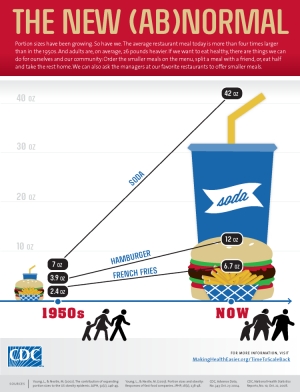
A Culture of Overconsumption: Portion Control
It seems apt, in the midst of the festive season – a holiday typified by consumption to excess of all sorts of goods, after all – to put forward a new topic in this series ‘A Culture of Overconsumption’. In this article, I will be considering the concept of ‘portion size’ and the role it plays in determining how much we eat. By ‘portion size’ I mean the amount of food that is placed on the plate in front of us, as we prepare to eat a meal or snack. This volume of food may be determined by us, or a family member, or a restaurant or a food producer (for example, if we were to follow the manufacturer instructions on serving size).
There’s no doubt that typical portion sizes have increased over recent decades. One classic example is that of the fizzy drink that often accompanies a fast food meal. Since the 1950s, the average size of one of these ‘fountain drinks’ has increased by 500%. And it’s not alone. Products like pies, pizzas and bagels have got noticeably bigger just since the 1990s.
Interestingly, one study looked at depictions of the Last Supper across 52 paintings and found that even that meal had grown exponentially in size. Between the year 1000 and the 1700s, the size of the main meal grew by 69%, with the bread also growing by around 20%. Between 1500 and 1900 was a period of particularly rapid rises in the sizes of the portions, and without a religious reason for the change, it must be considered that this probably reflects popular perceptions of the size of meals across time. In addition to meals, the same thing has happened to snacks. Few people can have failed to notice that we are now handed giant buckets of (sugary, fatty) popcorn when we enter cinemas or that ‘share bags’ (does anyone actually share??!) of crisps or sweets have become infinitely more common in recent years. With greater exposure comes less ability to discriminate an appropriate from a non-appropriate portion size. We’re almost trained by our food environment to shift our thinking on consumption norms to the extent that we may be affronted by a restaurant food portion that is appropriate and not lavishly oversized.
These trends, of course, coincide with increases in the frequency with which we eat outside of the home, and therefore the food industry - playing on our perceived needs for ‘value for money’ and indulgence - has considerable power over our total caloric intake. We are a nation of plate cleaners after all. Who wasn’t guilted into finishing everything on their plate as a child by references to those starving in Africa? Therefore, put more food on our plates and we will eat more. It’s a robust phenomenon that has been shown time and again in laboratory settings and in ‘real-world’ environments.
However, there are some subtleties to consider. Even before the food has reached our plate, certain factors can influence how much will end up there. Plate size is one. In studies, if people are given larger dishware with which to serve themselves, they will take more food (and thus, likely eat more). If a larger spoon or other serving utensil is provided, they will scoop more onto their dish. If a greater number of items of food are available, say at a buffet, then more will be eaten overall. If we buy large quantities of food or drink from a supermarket (for example bulk purchasing or taking advantage of a ‘BOGOF’ deal) then, perhaps perversely, we often repurchase the same item sooner than if we had purchased it in smaller portions, because of the stimulating effect of the presence of the large portion in our homes on our intake.
Importantly, such overconsumption is rarely, if ever, compensated for at later eating occasions. Despite our many, varied and intricately clever systems for regulating food intake (hormones emerging from almost every step of the digestion pathway to tell our brain how the meal is going), we’re just not very good at knowing when we’ve had enough and therefore when to stop. Nor are we any good at saying “I overate at lunchtime, therefore I am going to reduce the size of my evening meal to ensure that my caloric consumption for today is not excessive”.
It just doesn’t happen, the previous load of excess calories is swept under the carpet in our minds (but carefully stored as fat by our bodies) and we continue to eat as normal from the next eating occasion onwards. Thus, the ‘portion size effect’ contributes to sustained overconsumption (the very sort that leads to weight gain). This is true regardless of demographic characteristics such as socioeconomic status, age, body mass index and sex. Worryingly, there are signs that children as young as 2 years of age may be susceptible to the intake-enhancing effects of large portion sizes.
Given the above, it’s clear that self-regulation of portion size, particularly as it relates to eating outside of the home and when snacking, is extremely challenging - particularly for those seeking to manage their weight. There may be things we can do about it. Pressure from public health bodies has led to the withdrawal of many of the ‘super-sized’ options available in fast food outlets. But a major cultural and societal shift has taken place in these ‘consumption norms’ over the last 50 or so years, and it would take a lot of work to reverse the trend. Would consumers be amenable to reduced portion sizes? The food industry is of course motivated by the need to make profits, and as there is already considerable distrust between consumers and the industry with regard to their motives for portion sizes, reductions are likely to be poorly tolerated by many.
As we sit down for our Christmas meals this year, few of us will be thinking we should go easy. Eating until we fall asleep in front of the family festive movie is tradition, and there’s no real harm in that as a once a year treat, but as we move beyond Christmas we might all like to take a look at the culture of the food environment around us in a new, critical light. Do we need 50% extra free? Maybe less really is more. Perhaps, as a start, we could try placing greater value on our health than our wallets. That’s one New Year’s resolution that may just make a difference.




